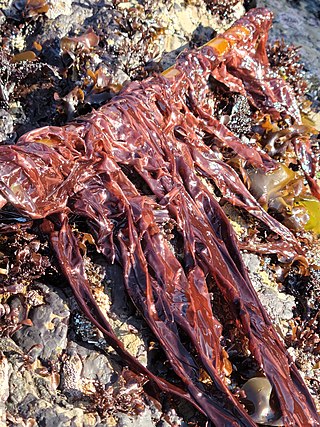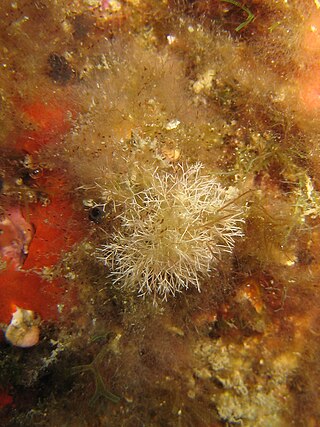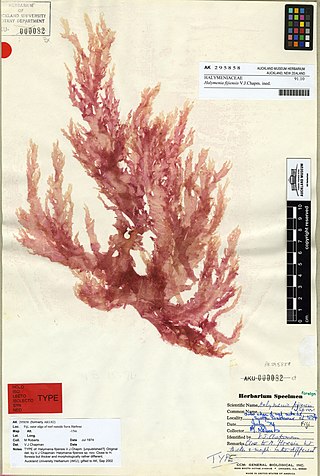Bangiaceae is a family of red algae in the order Bangiales. [3] It contains laver, used to make laverbread, and various species in the genus of Pyropia are used to make nori. [4]
Bangiaceae is a family of red algae in the order Bangiales. [3] It contains laver, used to make laverbread, and various species in the genus of Pyropia are used to make nori. [4]
Bangiaceae currently contains between 21 and 23 accepted genera, with all but one extant. [5]
Pyropia columbina, Southern laver, karengo in the Māori language and luche in the Spanish language, is a species of edible seaweed traditionally harvested by South Island Māori in New Zealand and Chilote people in Chile. It is closely related to Japanese Nori and Welsh laverbread.

Porphyra is a genus of coldwater seaweeds that grow in cold, shallow seawater. More specifically, it belongs to red algae phylum of laver species, comprising approximately 70 species. It grows in the intertidal zone, typically between the upper intertidal zone and the splash zone in cold waters of temperate oceans. In East Asia, it is used to produce the sea vegetable products nori and gim. There are considered to be 60–70 species of Porphyra worldwide and seven around Britain and Ireland, where it has been traditionally used to produce edible sea vegetables on the Irish Sea coast. The species Porphyra purpurea has one of the largest plastid genomes known, with 251 genes.

Leathesia marina (Lyngbye) Decaisne, 1842, previously known as Leathesia difformis Areschoug, 1847, commonly known as the sea cauliflower the sea potato, and brown brains is a species of littoral brown algae in the class Phaeophyceae and the order Ectocarpales, which is commonly attached to other seaweeds and sometimes rocks. When young, the organism is solid but as it matures it becomes hollow and somewhat convoluted and has the appearance of a small leathery brown bag about the same size as a tennis ball. The texture is rubbery and the outer surface smooth.

Wildemania is a genus of foliose red algae of the family Bangiaceae.

The Rivulariaceae are a family of cyanobacteria within the Nostocales in which the filaments (trichomes) are tapered from wider at the base to narrower at the tip.
Bangia is an extant genus of division Rhodophyta that grows in marine or freshwater habitats. Bangia has small thalli with rapid growth and high reproductive output, and exhibits behavior characteristic of r-selected species. The plants are attached by down-growing rhizoids, usually in dense purple-black to rust-colored clumps. The chloroplasts of Bangia, like others in the division Rhodophyta, contain chlorophyll a and sometimes chlorophyll d, as well as accessory pigments such as phycobilin pigments and xanthophylls. Depending on the relative proportions of these pigments and the light conditions, the overall color of the plant can range from green to red to purple to grey; however, the red pigment, phycoerythrin, is usually dominant.

Bangiales is an order of multicellular red algae of the class Bangiophyceae containing the families Bangiaceae, Granufilaceae, and possibly the extinct genus Rafatazmia with one species, Rafatazmia chitrakootensis. They are one of the oldest eukaryotic organisms, possibly dating back to 1.6 billion years old. Many species are used today as food in different cultures worldwide. Their sizes range from microscopic (Bangiomorpha) to up to two meters long. Many of its species are affected by Pythium porphyrae, a parasitic oomycete. Similar to many other species of red algae, they reproduce both asexually and sexually. They can be both filamentous or foliose, and are found worldwide.
Porphyra cinnamomea is a red alga species in the genus Porphyra, known from New Zealand. It is monostromatic, monoecious, and grows in the intertidal zone, predominantly on rock substrata. With P. coleana, P. rakiura and P. virididentata, they can be distinguished by morphology, as well as geographical, ecological and seasonal distribution patterns, and importantly, chromosome numbers, which in this species n = 3. Finally, these four species are distinguished by a particular nucleotide sequence at the 18S rDNA locus.

Clymene coleana, formerly known as Porphyra cinnamomea, is a red alga species in the family Bangiaceae. It is the only species in the monotypic genus Clymene. This species is endemic to New Zealand.
Pyropia rakiura, formerly known as Porphyra rakiura, is a red alga species in the genus Pyropia, known from New Zealand. It is monostromatic, monoecious, and grows in the intertidal zone, predominantly on rock substrata. With P. cinnamomea, P. coleana and P. virididentata, they can be distinguished by morphology, as well as geographical, ecological and seasonal distribution patterns, and importantly, chromosome numbers, which in this species n = 2. Finally, these four species are distinguished by a particular nucleotide sequence at the 18S rDNA locus.
Pyropia virididentata, formerly known as Porphyra virididentata, is a red alga species in the genus Pyropia. It is endemic to New Zealand. It is monostromatic, monoecious, and grows in the intertidal zone, predominantly on rock substrata. With Porphyra cinnamomea, Pyropia rakiura and Clymene coleana, they can be distinguished by morphology, as well as geographical, ecological and seasonal distribution patterns, and importantly, chromosome numbers, which in this species n = 3. Finally, these four species are distinguished by a particular nucleotide sequence at the 18S rDNA locus.

Pyropia is a genus of red algae in the family Bangiaceae. It is found around the world in intertidal zones and shallow water. The genus has folding frond-like blades which are either red, brown or green. Some Pyropia species are used to create nori, and are thus important subjects for aquaculture.

Phyllophora is a genus of red algae in the family Phyllophoraceae.

Liagoraceae is a family of red algae (Rhodophyta) in the order Nemaliales. The type genus is LiagoraJ.V.Lamouroux.

Halymeniales is an order of red algae belonging to the class Florideophyceae and the subclass Rhodymeniophycidae.
Ericaria is a genus of brown algae in the family Sargassaceae. It was formerly included in Cystoseira, but was recently found not to be closely related to it.
Kuwaitiella rubra is a species of filamentous red algae of the family Bangiaceae. It is the only species in its genus Kuwaitiella. It was discovered in 2022 by a team of five scientists in Kuwait, giving the name.

Neopyropia is a genus of foliose red algae of the family Bangiaceae described in 2020.